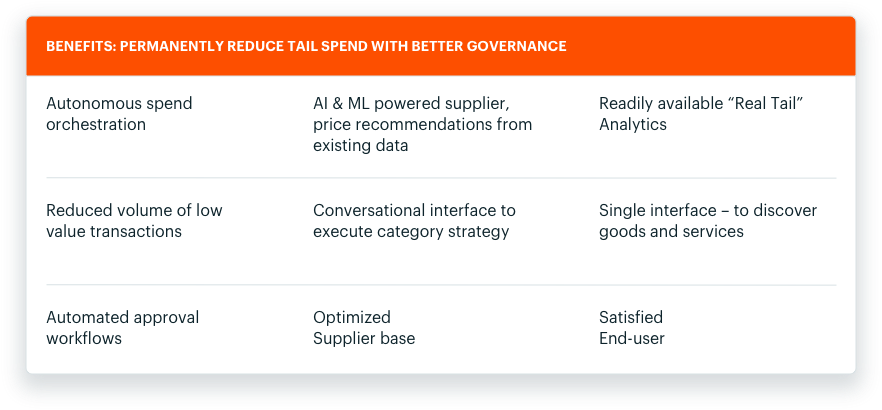

Summary
Most organizations run a tight ship when it comes to managing their strategic spend — i.e., top 80% of spend with a few strategic suppliers, while they are constantly finding better ways to manage Tail Spend.
Tail Spend, while constituting only 20% of the total spend, makes up for almost 80% of the transaction volume, and contributes to the increasing number of suppliers. Read this article to understand why Tail spend is equally critical and how organizations must tackle it to make their procurement more resilient.
John, a procurement manager at a large Fortune 500 company, is having a rough day. It’s time for annual planning, and yet again, he appears to be struggling with limited information about total spend. The company has been running many initiatives from time to time, to make procurement democratic and digital. Unfortunately, the outcome has not fully addressed all the challenges. While the main spend is managed well, the lower value spend in the indirect spend categories remains largely unaddressed.
Some of the challenges John is concerned about and would like to find answers to are common to other large organizations as well.
-
How can I reduce costs associated with low-value transactions?
-
How can I provide a more seamless buying experience to the end-user, removing their dependency on the Procurement team for low-value purchases?
-
How can I improve savings from low-value transactions?
-
How can I further leverage the best existing suppliers and reduce the need to create new suppliers?
-
How can I have better governance around the low value spend?
Most organizations run a tight ship when it comes to managing their strategic spend — i.e., top 80% of spend with a few strategic suppliers, while they are constantly finding better ways to manage Tail Spend.
According to the Boston Consulting Group, companies that can manage their Tail Spend using digital technologies can cut their annual spend by 5-10% on averageii . That could translate to millions in savings for large organizations!

How organizations typically manage Tail Spend
The constant evolution of technology and its applicability in addressing specific business challenges does provide a solution or the way forward to John’s challenges. An Intelligent Procurement Suite is undoubtedly the answer.
Loved what you read?
Get practical thought leadership articles on AI and Automation delivered to your inbox


Loved what you read?
Get practical thought leadership articles on AI and Automation delivered to your inbox
Technology Solutions available
Tail Spend management solutions have been available in the market over the last few years. Of late, business-to-business marketplaces have been re-positioning themselves as Tail Spend management solutions to tackle challenges faced by procurement organizations such as John’s to address Tail Spend challenges effectively. Large global organizations have invested in these solutions and have achieved early benefits. Over a period, the Tail Spend problem seems to resurface, calling for time and attention all over again. Can there be a definitive solution to John’s challenges?
How to Move the Dot
The need of the hour is a comprehensive digital solution. An AI-powered application that can make existing Tail Spend management techniques highly effective by automating the end-to-end cycle of events – from analysis to execution. One that can offer real-time spend visibility to the organization, provide insights to proactively support better governance, and improve the end requestor’s buying experience.

Money saved is money earned
In Deloitte’s Global CPO Survey 2019iii, 70% of respondents indicated that saving costs is a strong priority. The same survey found that consolidating spend is the top priority for organizations. This is especially relevant in times we find ourselves in today where there is a need for hyper-efficiency.
Procurement managers can have complete control over total spend, with reduced complexity. Improved management of Tail Spend can free up capital for better investments in the future of the company. And there is no better time than now.







